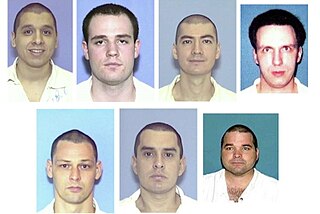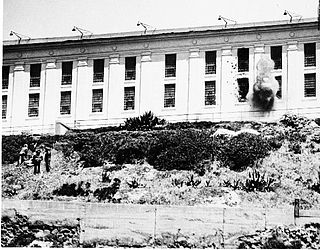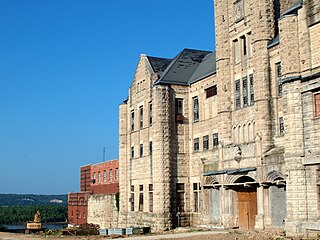Related Research Articles

Folsom California State Prison is a California State Prison in Folsom, California, U.S., approximately 20 miles (32 km) northeast of the state capital of Sacramento. It is one of 34 adult institutions operated by the California Department of Corrections and Rehabilitation.

The Texas 7 were a group of prisoners who escaped from the John B. Connally Unit near Kenedy, Texas, on December 13, 2000. Six of the seven were apprehended over a month later, between January 22–24, 2001, as a direct result of the television show America's Most Wanted. The seventh committed suicide before he could be arrested. The surviving members were all convicted and sentenced to death for the murder of Irving, Texas, police officer Aubrey Wright Hawkins, who was shot and killed when responding to a robbery perpetrated by the Texas Seven. Four of the six sentenced have since been executed.
Ponchai Kamau Wilkerson was a convicted murderer executed by lethal injection by the U.S. state of Texas. He was convicted for the 28 November 1990 murder of jeweler Chung Myong Yi. He was convicted by a jury on July 16, 1991, and ten days later sentenced to death by the same jury.

A prison escape is the act of an inmate leaving prison through unofficial or illegal ways. Normally, when this occurs, an effort is made on the part of authorities to recapture them and return them to their original detainers. Escaping from prison is also a criminal offense in some countries, such as the United States and Canada, and it is highly likely to result in time being added to the inmate's sentence, as well as the inmate being placed under increased security that is most likely a maximum security prison or supermax prison. In Germany, and a number of other countries, it is considered human nature to want to escape from a prison and it is considered as a violation of the right of freedom, so escape is not penalized in itself.
Troy Leon Gregg was the first condemned individual whose death sentence was upheld by the United States Supreme Court after the Court's decision in Furman v. Georgia invalidated all previous capital punishment laws in the United States. He later participated in the first successful escape from Reidsville State Prison death row with three other death row inmates, but was killed later that night by Timothy McCorquodale during a bar fight.
Adriana Nicole Marines was a 5-year-old American girl of Mexican descent, who was murdered in her Corpus Christi, Texas home. Her murder sparked widespread local and nationwide media attention.

The Battle of Alcatraz, which lasted from May 2 to 4, 1946, was the result of an escape attempt at Alcatraz Federal Penitentiary by armed convicts. Two Federal Bureau of Prisons officers—William A. Miller and Harold Stites—were killed. Three inmates were also killed during the incident. Fourteen other officers and one uninvolved convict were also injured. Two of the perpetrators were executed in 1948 for their roles.
The Maze Prison escape took place on 25 September 1983 in County Antrim, Northern Ireland. HM Prison Maze was a maximum security prison considered to be one of the most escape-proof prisons in Europe. It held prisoners suspected of taking part in armed paramilitary campaigns during the Troubles, with separate wings for loyalists and for republicans. In the biggest prison escape in UK history, 38 Provisional Irish Republican Army (IRA) prisoners escaped from H-Block 7 (H7) of the prison. One prison officer died of a heart attack during the escape and twenty others were injured, including two who were shot with guns that had been smuggled into the prison.

The Maryland Metropolitan Transition Center (MTC), formerly known as the historic "Maryland Penitentiary", is a maximum pre-trial security Maryland Department of Public Safety and Correctional Services prison located in Baltimore facing Greenmount Avenue between Forrest Street and East Madison Street. It was established in 1811 as the first prison in the state and the second of its kind in the country and the original buildings faced towards East Madison Street above the east bank of the Jones Falls stream and adjacent to the old stone walls of the Baltimore City Jail, earlier established in 1801, rebuilt in 1857–1859, and later in 1959–1965.

Allan B. Polunsky Unit is a prison in West Livingston, unincorporated Polk County, Texas, United States, located approximately 5 miles (8.0 km) southwest of Livingston along Farm to Market Road 350. The Texas Department of Criminal Justice (TDCJ) operates the facility. The unit houses the State of Texas death row for men, and it has a maximum capacity of 2,900. Livingston Municipal Airport is located on the other side of FM 350. The unit, along the Big Thicket, is 60 miles (97 km) east of Huntsville.

The Missouri State Penitentiary was a prison in Jefferson City, Missouri, that operated from 1836 to 2004. Part of the Missouri Department of Corrections, it served as the state of Missouri's primary maximum security institution. Before it closed, it was the oldest operating penal facility west of the Mississippi River. It was replaced by the Jefferson City Correctional Center, which opened on September 15, 2004.

O. B. Ellis Unit is a Texas Department of Criminal Justice prison located in unincorporated Walker County, Texas, 12 miles (19 km) north of Huntsville. The unit, with about 11,427 acres (4,624 ha) of space, now houses up to 2,400 male prisoners. Ellis is situated in a wooded area shared with the Estelle Unit, which is located 3 miles (4.8 km) away from Ellis. From 1965 to 1999 it was the location of the State of Texas men's death row.

Central Prison is a prison operated by the North Carolina Department of Public Safety in Raleigh, North Carolina. The prison, west of Downtown Raleigh, is on 29 acres (12 ha) of land and is bounded by a double wire fence with a razor ribbon on top. The Department of Public Safety website describes the original building as "castle-like."

Gustavo Julian Garcia Jr. was an American prisoner from McKinney, Texas, who was executed for the 1990 murder of Craig Turski.
Quincy Jovan Allen is an American serial killer who killed four people between July and August in a crime spree in 2002. He was sentenced to death for his crimes in South Carolina, and is currently awaiting execution.

Laron Ronald Williams was an American serial killer. Originally convicted in the 1977 murder of a prostitute in Nashville, Tennessee and suspected in at least two similar killings, Williams later escaped from prison and murdered a police officer and a priest within days of one another in 1981. He was separately sentenced to death for both murders, but was killed by fellow inmates on death row in 1985 before he could be executed.
Ramirez v. Collier, 595 U.S. ___ (2022), is a United States Supreme Court case related to the First Amendment to the United States Constitution and the Religious Land Use and Institutionalized Persons Act.
Gonzalo Artemio Lopez was an American fugitive, mass murderer, and prison escapee who killed a total of six people in separate murders in 2005 and 2022. In 2005, Lopez kidnapped and murdered a man in Weslaco, Texas. He was convicted of capital murder and sentenced to life in prison. In May 2022, Lopez received international attention when he escaped from prison custody by assaulting a corrections officer and fleeing from a prison bus. He became a wanted fugitive and evaded authorities for three weeks. On June 2, Lopez broke into a ranch and murdered five people from the same family, including three children, before stealing weapons and a pickup truck. Later that same day, police spotted Lopez and engaged in a shootout with him after a high-speed chase, where he was fatally shot during the exchange of gunfire.
References
- 1 2 3 Lyman, Rick (1998-11-28). "Texas Death Row Inmate Pulls Off Escape". The New York Times. ISSN 0362-4331 . Retrieved 2018-01-16.
- 1 2 3 KOLKER, CLAUDIA; HART, LIANNE (1998-12-04). "Escaped Death Row Inmate Found Dead". Los Angeles Times. ISSN 0458-3035 . Retrieved 2018-01-16.
- ↑ "Shadow Figures: A Portrait of Life on Texas Death Row". Mother Jones. Retrieved 2018-01-16.
- 1 2 Lyman, Rick (1998-12-04). "Death Row Escapee Found Dead". The New York Times. ISSN 0362-4331 . Retrieved 2018-01-16.